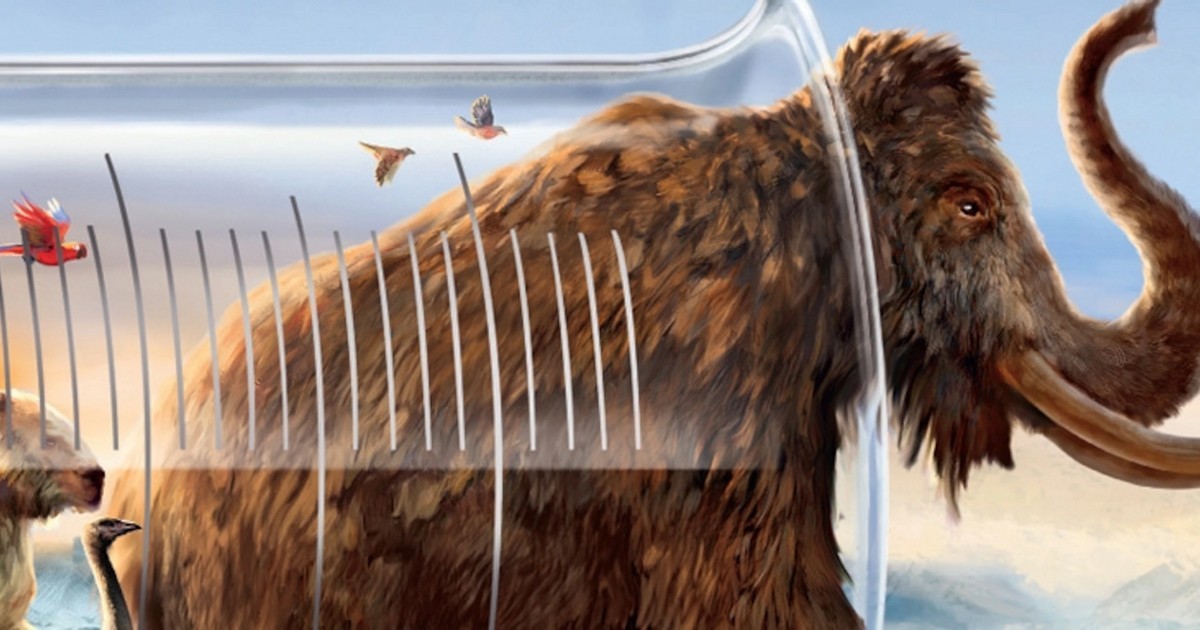劍橋雅思 15 測驗第二回閱讀第二篇文章探討我們是否應該利用最新的基因工程技術將已經滅絕但是卻可能有益於環境生態發展的物種重新加以復活,從事此方面研究的科學家提出了值得深思的忠告。
本篇文章共分 A-F 5 大段,從幾種已經絕種的生物目前的去滅絕計畫研究開始,探討此種基因技術的目的與實際的可能成效,並提出應該具備的正確觀念,並展望未來的發展。
本篇考題英文原文與對應之中文翻譯整理如下。練習作答解題時若有對語意不清楚之處,請仔細查閱對照,以提升閱讀理解能力。
Should We Try to Bring Extinct Species Back to Life? 我們是否應該嘗試讓滅絕的物種復活?
-
旅鴿的復活計畫
The passenger pigeon was a legendary species. Flying in vast numbers across North America, with potentially many millions within a single flock, their migration was once one of nature’s great spectacles. Sadly, the passenger pigeon’s existence came to an end on 1 September 1914, when the last living specimen died at Cincinnati Zoo. Geneticist Ben Novak is lead researcher on an ambitious project which now aims to bring the bird back to life through a process known as ‘de-extinction’. The basic premise involves using cloning technology to turn the DNA of extinct animals into a fertilised embryo, which is carried by the nearest relative still in existence – in this case, the abundant band-tailed pigeon – before being born as a living, breathing animal. Passenger pigeons are one of the pioneering species in this field, but they are far from the only ones on which this cutting-edge technology is being trialled.
旅鴿是一個具有傳奇色彩的物種。它們以巨大的數量飛越北美,在一個鴿群中可能有數百萬隻,它們的遷徙曾經是自然界中最偉大的奇觀之一。不幸的是,當最後一隻活體樣本在辛辛那提動物園死亡時,旅鴿的生存在 1914 年 9 月 1 日結束了。遺傳學家本.諾瓦克是一項雄心勃勃的計畫中的首席研究員,該計畫旨在通過一個被稱為「去滅絕」的過程使這種鳥復活。其基本前提是利用無性繁殖技術將已滅絕動物的 DNA 轉化為受精胚胎,由仍然存在的最近的親屬—在本案例中是數量豐富的斑尾鴿—懷胎,然後再誕生出一隻活生生的動物。旅鴿是此一領域的先鋒物種之一,但它們絕非是這種尖端技術正在試驗的唯一物種。
-
袋狼的復活研究
In Australia, the thylacine, more commonly known as the Tasmanian tiger, is another extinct creature which genetic scientists are striving to bring back to life. ‘There is no carnivore now in Tasmania that fills the niche which thylacines once occupied,’ explains Michael Archer of the University of New South Wales. He points out that in the decades since the thylacine went extinct, there has been a spread in a ‘dangerously debilitating’ facial tumour syndrome which threatens the existence of the Tasmanian devils, the island’s other notorious resident. Thylacines would have prevented this spread because they would have killed significant numbers of Tasmanian devils. ‘If that contagious cancer had popped up previously, it would have burned out in whatever region it started. The return of thylacines to Tasmania could help to ensure that devils are never again subjected to risks of this kind.’
在澳大利亞,袋狼,也就是更為人所熟知的塔斯馬尼亞虎,是另一種滅絕的生物,基因科學家正在努力使其復活。新南威爾斯大學的邁可‧阿徹解釋說:「現在在塔斯馬尼亞沒有食肉動物可以填補袋狼曾經佔據的位置。」他指出,在袋狼滅絕後的幾十年裡,一種「具有危險傷害性」面部腫瘤綜合症候群已經蔓延,威脅到袋獾的生存,這是島上另一種知名的居民。袋狼可以防止這種擴散,因為它們會殺死大量的袋獾。「如果這種傳染性的癌症以前突然出現,無論它在哪個地區開始,它都會被燒毀。袋狼回到塔斯馬尼亞可以幫助確保袋獾不再受到這種危險之害。」
-
去滅絕的方法
If extinct species can be brought back to life, can humanity begin to correct the damage it has caused to the natural world over the past few millennia? ‘The idea of de-extinction is that we can reverse this process, bringing species that no longer exist back to life,’ says Beth Shapiro of University of California Santa Cruz’s Genomics Institute. ‘I don’t think that we can do this. There is no way to bring back something that is 100 per cent identical to a species that went extinct a long time ago.’ A more practical approach for long-extinct species is to take the DNA of existing species as a template, ready for the insertion of strands of extinct animal DNA to create something new; a hybrid, based on the living species, but which looks and/or acts like the animal which died out.
如果滅絕的物種可以復活,人類是否可以開始糾正它在過去幾千年中對自然界造成的損害?加利福尼亞大學聖塔克魯茲分校基因組學研究所的貝絲.夏皮羅說:「去滅絕的想法是,我們可以逆轉這一過程,使不再存在的物種重新獲得生命。我不認為我們能做到這一點。沒有辦法讓與很久以前滅絕的物種百分之百相同的東西復活。」對於早已滅絕的物種,更實用的方法是以現有物種的 DNA 為範本,準備插入已滅絕動物的 DNA 鏈,以創造出新的東西;一種基於活體物種的雜交體,但其外觀和/或行為與已滅絕的動物一樣。
-
去滅絕的實際意義
This complicated process and questionable outcome begs the question: what is the actual point of this technology? ‘For us, the goal has always been replacing the extinct species with a suitable replacement,’ explains Novak. ‘When it comes to breeding, band-tailed pigeons scatter and make maybe one or two nests per hectare, whereas passenger pigeons were very social and would make 10,000 or more nests in one hectare.’ Since the disappearance of this key species, ecosystems in the eastern US have suffered, as the lack of disturbance caused by thousands of passenger pigeons wrecking trees and branches means there has been minimal need for regrowth. This has left forests stagnant and therefore unwelcoming to the plants and animals which evolved to help regenerate the forest after a disturbance. According to Novak, a hybridized band-tailed pigeon, with the added nesting habits of a passenger pigeon, could, in theory, re-establish that forest disturbance, thereby creating a habitat necessary for a great many other native species to thrive.
這種複雜的過程和值得懷疑的結果引出了一個問題:這項技術的實際意義是什麼?諾瓦克解釋說:「對我們來說,我們的目標一直是用合適的替代品來取代已滅絕的物種。當談到繁殖時,斑尾鴿是散居的,每公頃可能有一、兩個巢,而旅鴿是非常社會化的,在一公頃內會有 10,000 個或更多的巢。」自從這個關鍵物種消失後,美國東部的生態系統就受到了影響,因為缺乏由成千上萬隻旅鴿所造成的樹木和樹枝損壞,意味著樹木不太需要重新生長。這使得森林停滯不前,因此對於那些在擾動後幫助森林再生的植物和動物的進化來說,成為一個不受歡迎的現象。根據諾瓦克的說法,雜交的斑尾鴿,加上旅鴿的築巢習慣,在理論上可以重新建立森林的干擾,從而為許多其他本地物種的繁榮創造一個必要的棲息地。
-
長毛象的研究
Another popular candidate for this technology is the woolly mammoth. George Church, professor at Harvard Medical School and leader of the Woolly Mammoth Revival Project, has been focusing on cold resistance, the main way in which the extinct woolly mammoth and its nearest living relative, the Asian elephant, differ. By pinpointing which genetic traits made it possible for mammoths to survive the icy climate of the tundra, the project’s goal is to return mammoths, or a mammoth-like species, to the area. ‘My highest priority would be preserving the endangered Asian elephant,’ says Church, ‘expanding their range to the huge ecosystem of the tundra. Necessary adaptations would include smaller ears, thicker hair, and extra insulating fat, all for the purpose of reducing heat loss in the tundra, and all traits found in the now extinct woolly mammoth.’ This repopulation of the tundra and boreal forests of Eurasia and North America with large mammals could also be a useful factor in reducing carbon emissions – elephants punch holes through snow and knock down trees, which encourages grass growth. This grass growth would reduce temperature, and mitigate emissions from melting permafrost.
這項技術的另一個熱門候選者是長毛象。哈佛大學醫學院教授、長毛象復興計畫的負責人喬治.丘奇一直在關注抗寒性,這是已經滅絕的長毛象與其最近的活體親屬亞洲象的主要區別。通過確定哪些遺傳特徵使長毛象有可能在苔原的冰冷氣候中生存,該計畫的目標是使長毛象或類似長毛象的物種重返該地區。「我最優先考慮的是保護瀕危的亞洲象,」丘奇說,「將它們的範圍擴大到苔原的巨大生態系統中。必要的適應性將包括較小的耳朵、較厚的毛髮和額外的絕緣脂肪,所有這些都是為了減少苔原上的熱量損失,而且所有的特徵都可以在現已滅絕的長毛象身上找到。」這種用大型哺乳動物重新補充歐亞大陸和北美的苔原和北方森林的做法,也可能是減少碳排放的一個有用因素—大象在雪地上打洞,撞倒樹木,從而促進草的生長。這種草的生長將降低溫度,並減輕來自永久凍土融化的碳排放。」
-
正確觀念與未來展望
While the prospect of bringing extinct animals back to life might capture imaginations, it is, of course, far easier to try to save an existing species which is merely threatened with extinction. ‘Many of the technologies that people have in mind when they think about de-extinction can be used as a form of “genetic rescue”,’ explains Shapiro. She prefers to focus the debate on how this emerging technology could be used to fully understand why various species went extinct in the first place, and therefore how we could use it to make genetic modifications which could prevent mass extinctions in the future. ‘I would also say there’s an incredible moral hazard to not do anything at all,’ she continues. ‘We know that what we are doing today is not enough, and we have to be willing to take some calculated and measured risks.’
雖然讓滅絕的動物重獲新生的前景可能會吸引人們的想像,但當然,試圖拯救一個僅僅面臨滅絕威脅的現有物種要容易得多。夏皮羅解釋說:「當人們想到滅絕的時候,他們想到的許多技術都可以作為一種『基因救援』的形式使用。」她更傾向於將辯論的重點放在如何利用這種新興技術來充分瞭解各種物種最初滅絕的原因,因此我們如何利用它來進行基因改造,從而防止未來的大規模滅絕。她繼續說:「我還想說,完全不做任何事情會有難以置信的道德風險。我們知道我們今天所做的仍然不夠,我們必須願意承擔一些經過計算和衡量的風險。」
